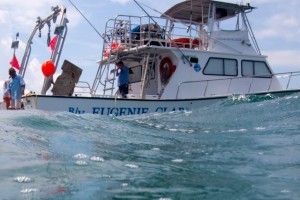
Chemical & Physical Ecology
Studying the impacts of nutrients and physical parameters in riverine, estuarine and coastal environments.
1600 Ken Thompson Parkway
Sarasota, FL 34236
Ph: (941) 388-4441
Hours: 10AM - 5PM
A 501(c)3 nonprofit organization.
The Fisheries Habitat Ecology and Acoustics program focuses on how fishes interact with their habitats and how disturbances influence these interactions. By understanding how fish use habitats, we can develop a better understanding of how disturbances impact these fish-habitat interactions and ultimately how disturbances affect fish populations.
Natural and anthropogenic (man-made) disturbances do not generally have similar impacts on coastal habitats and fishes, so one of our research goals is to determine how natural (e.g., hurricanes) and anthropogenic (e.g., coastal development) interact and what the resulting ecological impacts are.
The Fisheries Habitat Ecology and Acoustics Program focuses on coastal fishes, ranging from coral reef fishes to economically important sport fish. In all cases, the focal species are tools to learn about coastal ecological processes. Most recently, the focus has been on recreationally important species, including common snook, bonefish, tarpon and permit. All of these are economically important sport fish throughout the Caribbean.
The overall goal of the program is to use theoretical ecology to help frame applied research, and to then use the research findings to improve the way coastal fisheries resources are managed and conserved.
By necessity, this means that we make extra effort to conduct extensive outreach and education intended to educate user groups, local communities, resource managers and political leaders about coastal ecosystems.
One way in which we do this is to involve recreational anglers in our research so that they learn about how science is conducted, become better educated about the resource and become better stewards of coastal resources.
Mote Aquarium is likely to be busy this week, with many timed-ticket entry slots selling out. Please purchase your tickets in advance to guarantee entry.
Mote Aquarium is open seven days a week at our normal hours, 9:30 a.m.–5 p.m. We hope to SEA you soon!